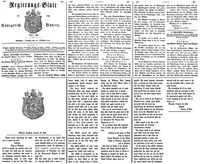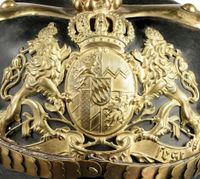Interesting facts about the plate from the M1886 helmet of the Royal Bavarian Army
In the "Militar-Wochenblatt Nr. 103" from the annual collection volume 61 from 1886, there was an interesting article about the introduction of the new helmet model M1886 in Bavaria (Fig. 1). Unlike most other German states, the Pickelhaube was not introduced for most of the Bavarian army until September of that year. Until then, only the gendarmerie, which was part of the military at the time, or the two heavy cavalry regiments wore spiked helmets similar to the Prussian pattern. The pickelhaube was first introduced in Bavaria on 26.9.1848 for the Landwehr.1 This had a crowned shield with the Bavarian coat of arms, surrounded by laurel and palm branches, as helmet emblem. On June 7, 1856, a spiked helmet was introduced for the gendarmerie2, which had the royal cipher as an emblem on the helmet. It was a Gothic "M" with crown, for King Maximilian II. Both, however, were far from being able to keep up with the highly dressy emblems of the other German states. Also the pickelhaube of the heavy riders, who wore the helmet since 1.4.1879 (but it was already introduced with the decree of 29.11.1878) had only a name cipher on the helmet. At that time, however, King Ludwig II already ruled, so here it was a Gothic "L" with crown. Only with the Gendarmerie helmet M1873 (introduced on September 6, 1873 3, but only approved by the Bavarian Ministry of War on November 10, 1873 4), was a Bavarian pickelhaube introduced, whose helmet emblem was already very similar to the M1886, but was still somewhat plainer.
But now back to the article. This credits the artists who designed the new and magnificent emblem for the Bavarian M1886 helmets and carved the same into the steel of the moulds. The Bavarian government spared nothing for this, because according to the article, the best artists of their guild were commissioned for this work.
The design of the helmet plate was modeled by the sculptor ANTON PRUSKA (1.6.1846 - 24.7.1930 - wrongly mentioned in the article as BRUSKA), who was a student of the famous Munich sculptor LORENZ GEDON (24. 11.1844 - 27.12.1883). This design was then cut by an engraver named Hormann, most likely the court engraver RUDOLF HORRMANN (28.8.1846 - ??? - unfortunately also misspelled in the article) into the steel of the press mold blank, which was then used to press the emblems of the Bavarian M1886 helmets.
The helmet emblem was modeled by Anton Pruska entirely according to the rules of heraldry. The shield holders are 2 beautifully crafted Bavarian lions with crown. In their paws they hold the main oval shield crowned with a large crown of the Bavarian royal house. As already mentioned, the coat of arms template used by Pruska was similar to the plate of the M1873 gendarmerie helmet, but was introduced as the official Bavarian coat of arms much earlier, in 1835 by King Ludwig I of Bavaria (Figure 2). Incidentally, the 2 tails of the lions are said to have been originally created once by a mistake made by a seal engraver, who then imaginatively concealed it.5 But this is only a small anecdote.
The main oval shield was divided into four, each field standing for a territory, which then merged into the Kingdom of Bavaria.6
- Above left the lion shield of the Count Palatine of the Rhine, which was led since 1214 by the Wittelsbachers, the dynasty of the "von Bayern". The horizontally and vertically running cross-hatching in the background of this field stands for the black color in heraldry. The lion on it has no pox, rather the dots on its fur stand in the heraldry also for a color, namely the golden one.
- To the right, for the Franconians, the "Franconian Rake". 3 silver points on a red ground, whereby the red is represented in the heraldry with a vertical hatching. Silver, on the other hand, like the white color, has no pattern in heraldry.
- Below left, the Swabian badge, consisting of several diagonal bars, alternating in silver and red. On it a vertical golden stake, which originated from the arms of the Margraviate of Burgau in Swabia.
- Below right the "Veldenzier Löwe", a blue lion with a golden crown on a silver background. This comes from the coat of arms of the Dukes of Zweibrücken. The blue color of the lion was represented by a horizontal hatching, which unfortunately is not well visible on many coats of arms. There are sometimes also small dots on the crown, for the golden color, but they are very small and not always present. They were probably too difficult to realize in the pressing.
- Centered above the main oval shield floated the heart shield with the Bavarian diamonds running diagonally, alternating in silver and blue (daredevil hatching). This was and is the original Bavarian symbol.
The motto "IN TRUE FEST" was the motto of the Bavarian army since the beginning of the 19th century, when Bavaria and Europe freed themselves from Napoleonic foreign rule. However, the slogan had its origins much earlier, as it was already the motto of the Order of St. Hubert of the Duchy of Jülich-Berg, founded in 1444.7
The laurel branches crossing under the main shield are again taken from the description of the coat of arms from 1835, where laurel and palm branches are already described for the official seals of the authorities. The magnificent representation, with the leaves snaking between the legs of the lions, was entirely in keeping with the taste of the time. It was the time of historicism, which was very ornate and, from today's perspective, often a bit overloaded. At that time, however, the rococo was fashionable again and the decorations were accordingly expansive. In addition, in heraldry, laurel stands for luck, salvation and glory8, so it was a very appropriate adornment for the plate.
The large Bavarian plate of the M1886 helmets impresses, as it is also true for the other Pickelhauben platea, by its artistic design and the very high level of detail. It was made with great care and is truly a beautiful helmet emblem. The comparison with the helmet emblems of the other German states it did not need to shy away in any case more.
Sources (in German):
- Fortgesetzte Sammlung der im Gebiete der inneren Staats-Verwaltung des königreichs Bayern bestehenden Verordnungen von 1835-1852
- Verordnungs-Blatt des königlich bayerischen Kriegsministeriums, Nr. 12/1856
- Verordnungs-Blatt des königlich bayerischen Kriegsministeriums (1873), No. 44/1873
- Neue Würzburger Zeitung No. 315, volume 70 (1873), page 87
- J. Siebmachers grosses und allgemeines Wappenbuch, Einleitungsband, Abteilung A und B - von Johann Siebmacher (1890), page 672
- J. Siebmachers großes und allgemeines Wappenbuch, volume 1, 1. part: „Außerdeutsche Staatenwappen“ - by Dr. Otto Titan von Hefner (1856)
- Pierers Konversations-Lexikon, Band 2 - by Joseph Kürschner (1889), page 621
- Die Symbolik und Mythologie der Natur, by J. B. Friedreich (1859), page 299


